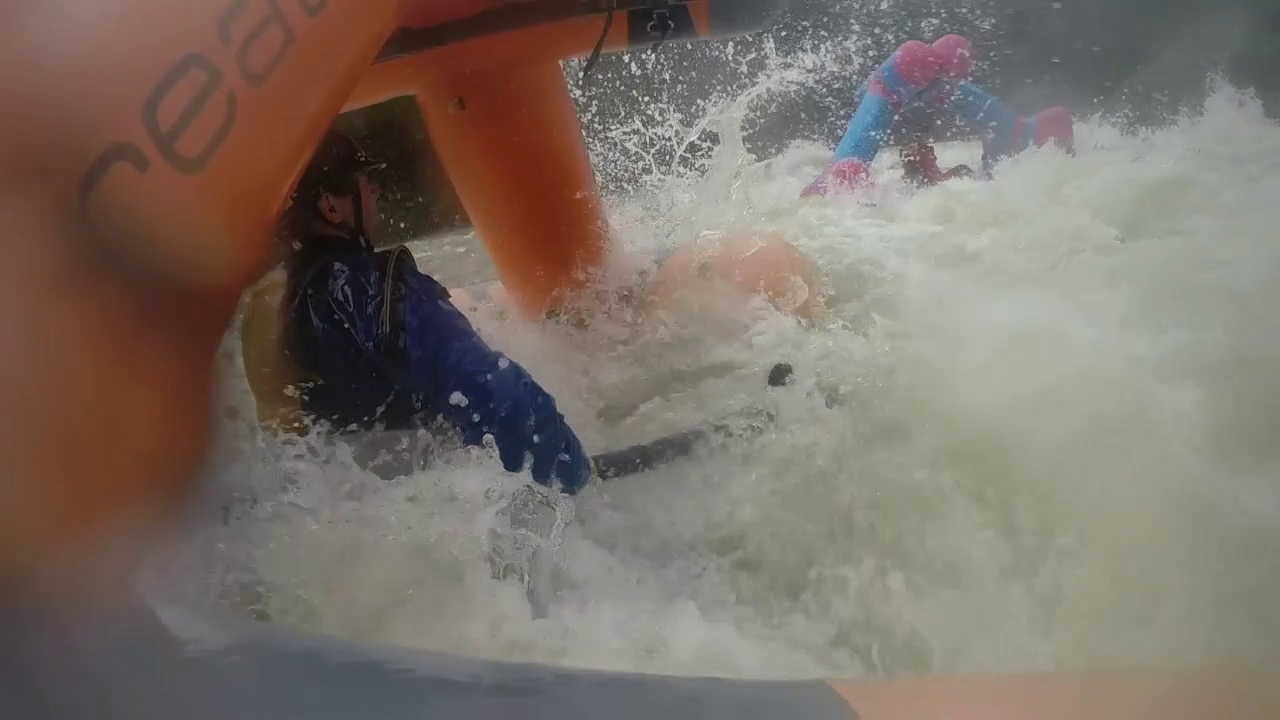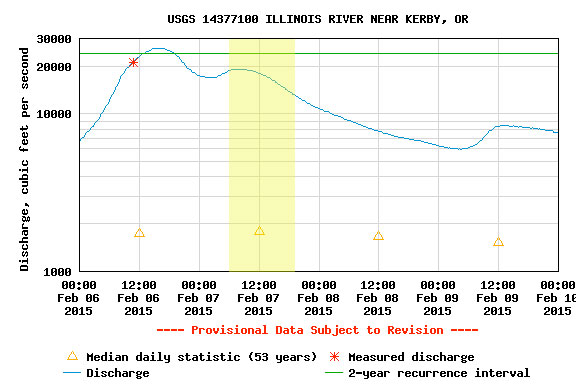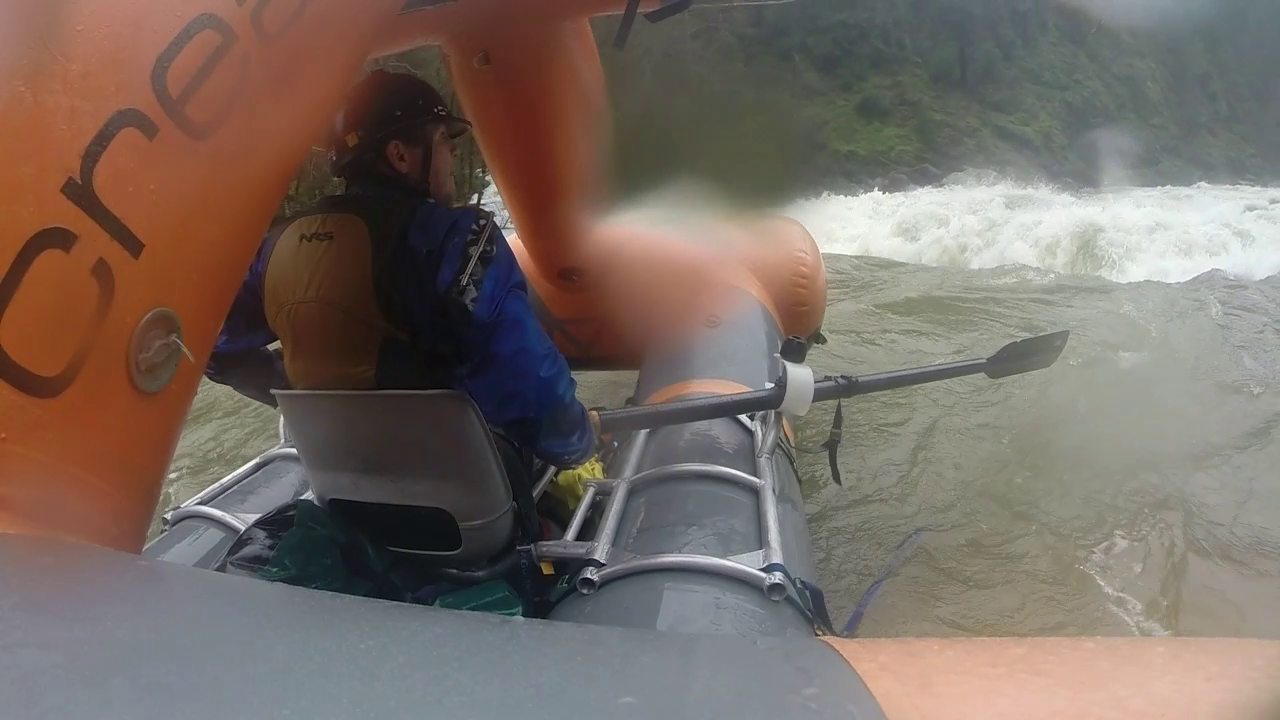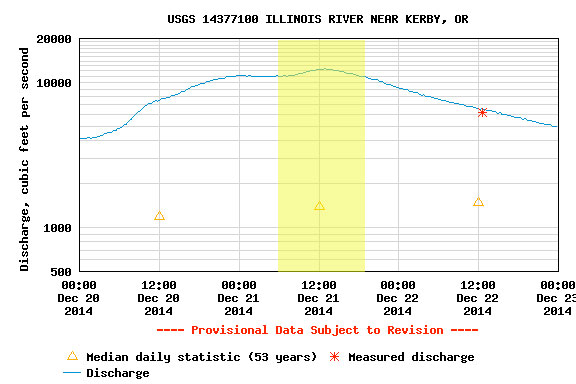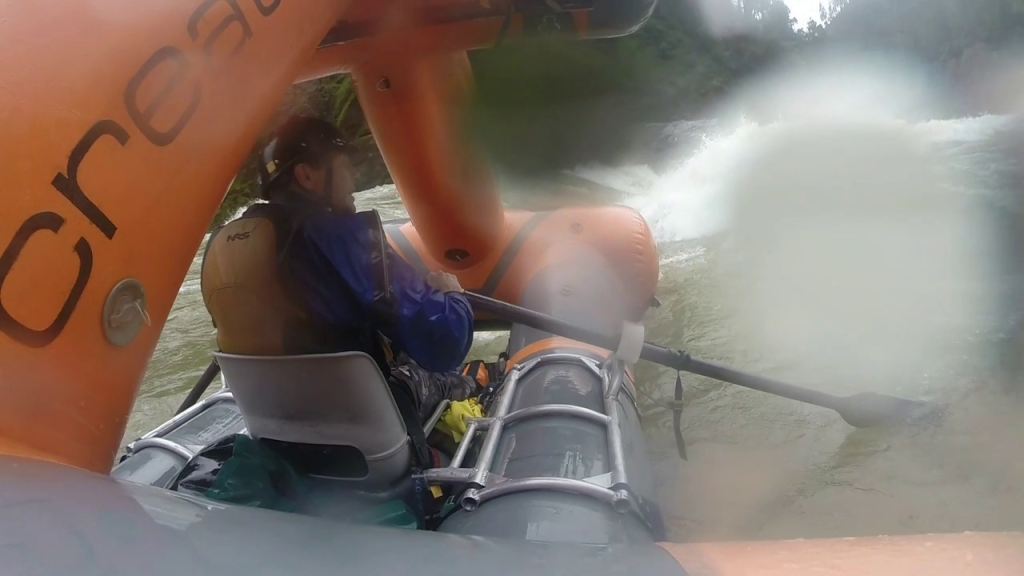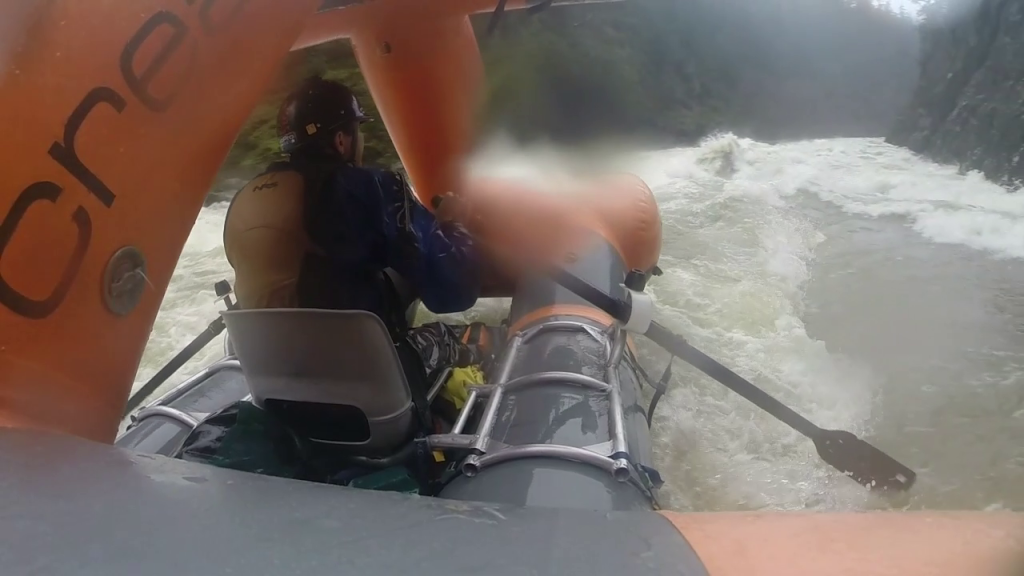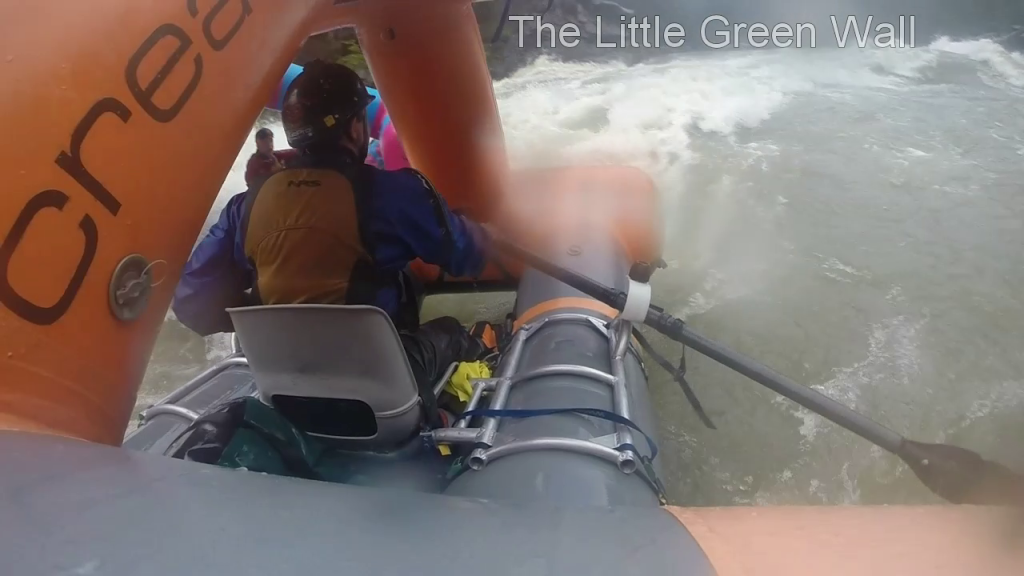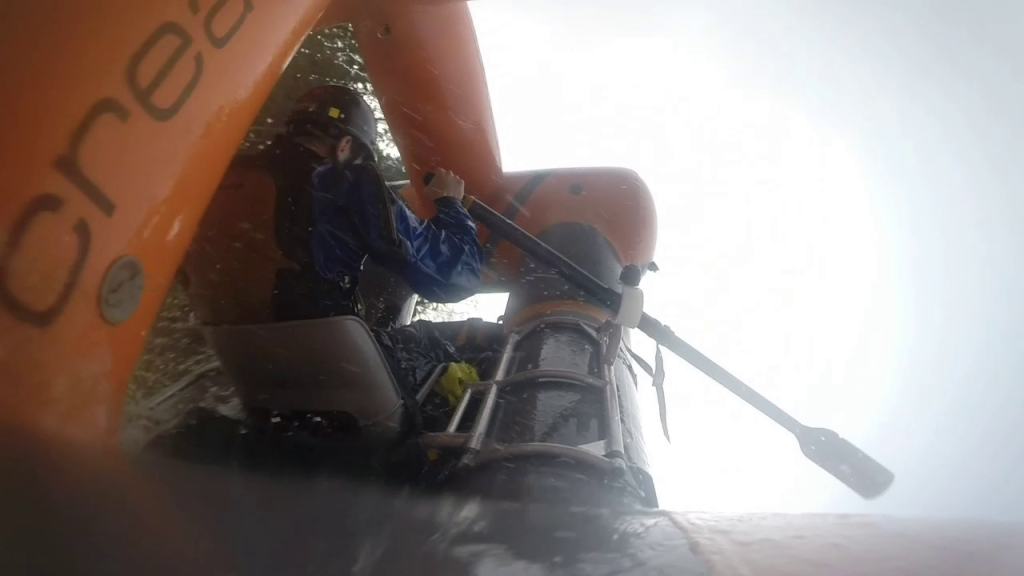Saturday night, November 26, 2016:
Things had seriously gone wrong. We were in a bad spot. Soaked in my drysuit, I was standing on a narrow ledge, holding a piece of cold soggy fried chicken. It was dark, and a colder rain had started to fall. I was hoping for the sound of a whistle, but with other than the sound of river and the others huddled in the tent next to me the only sounds I heard were the mistakes of this afternoon running through my head…
About a week earlier:
I was in Michigan visiting with my girlfriend Donna, hanging out at a USFS bunk house on the Ottawa National Forest. We would be driving back west shortly and so I checked the weather forecasts. I wanted to see where the snow was going to be so we could hopefully avoid it on our drive back. But perhaps more importantly the river forecasts for SW Oregon/NW California were more on my mind. I got excited after I saw that a series of fronts were forecast to come through SW Oregon just after our arrival. Flood watches were already posted. The flow forecast for the Illinois was to peak at 29k.
I had some butterflies in my stomach thinking about it. I had been on four or five highwater Illinois trips. Some went better than others. Donna has been super supportive of my river trips, and I told her I was looking at hitting the Illy the day after Thanksgiving. I put some word out, and got a little interest. However, as we drove west, and the date got closer, the forecast kept lowering. I had already talked myself into running a 20k+ trip and anything less than that started to feel easy. A couple days later the forecast had lowered to a peak around 15k. Still a healthy level, and I felt at this point with all the talk of multiple very wet fronts that they were underforecasting. However, by the time I got back, a trip was in the works and we were looking at flows peaking around 9k on a Saturday.
I thought this would be a great trip to invite Donna on. The character of the Illinois seems to change around 11 or 12 thousand and the forecast was well below that. On my 7k float I thought all the rapids were relatively easy, although a few had some sticky holes. So I asked, and she accepted. By the evening before launch I had rounded up myself + 4, to embark on what I figured would be even lower, a relatively mellow Illy trip at about 5k – 6k. Again, the flow forecast kept getting lower and lower, and when I got up at 6 AM on Saturday the rain that was supposed to arrive at midnight didn’t, and the Illinois was now at 4500 and still dropping. I thought that some people on the trip might want to cancel. However, after I sent some texts I found out this was not the case. After loading the truck, picking up some folks, finding a trailer, and picking up our shuttle driver (Bearfoot Brad), we decided to turn our one day trip into an overnight due to the lower flows, and now a late start. At around 10:30 AM we arrived at McCaleb Ranch. With an overnight trip in mind we were not really in a hurry. We all agreed we’d like to make it through the Green Wall at a higher flow rather than lower, however, and so we set our planned camp at Collier Creek.
Inflating, and rigging our rolled boats took a while, and when everything was said and done we put on the water just before 1 pm, about 4 hours before dark. The members of this trip were Donny rowing on his own, Dave rowing another with Marcello riding along, and Donna and I were going to trade off rowing another boat.
The flow was really fun. On an overnight trip, putting in at McCaleb Ranch should be your first choice. There are a lot of quality class 3 to 3+ rapids between the ranch and Miami Bar. It adds 6 more miles of whitewater, and cuts out 45 minutes of driving down a fairly bumpy gravel/dirt road. Even at low flows of 900 or so, it only adds a couple hours to your float. At 4k it’s a quick 60-45 minute float if you stay in the current.
There were some really fun surf holes right off the bat. The rapid that usually kicks your ass right around the corner from McCaleb, wasn’t really that bad, but did have a big enough hole to give me a fun surf, and Donny was able to do a barrel roll or two. After a couple miles things calmed down. The water was moving, with 5-6 foot wave trains and some good sized boils. There weren’t really any good surfing holes, but it gave a chance for everyone to get better acquainted with there boats. The float from Miami Bar to Panther Creek was flat and the sun we had earlier was replaced with a steady cold rain. We pushed through the flats and were all happy to get back into some better rapids once below Briggs Creek.
Panther Creek through Nome Creek rapids were fairly mellow read and run with some bigger waves, probably around 7 to 8 feet. Rocky Drop (aka Rapid 19) has some large lateral waves and a big pour over on the left formed by the usual rock that sticks out at the bottom. All of these were super read and run, with lots of room to move around.
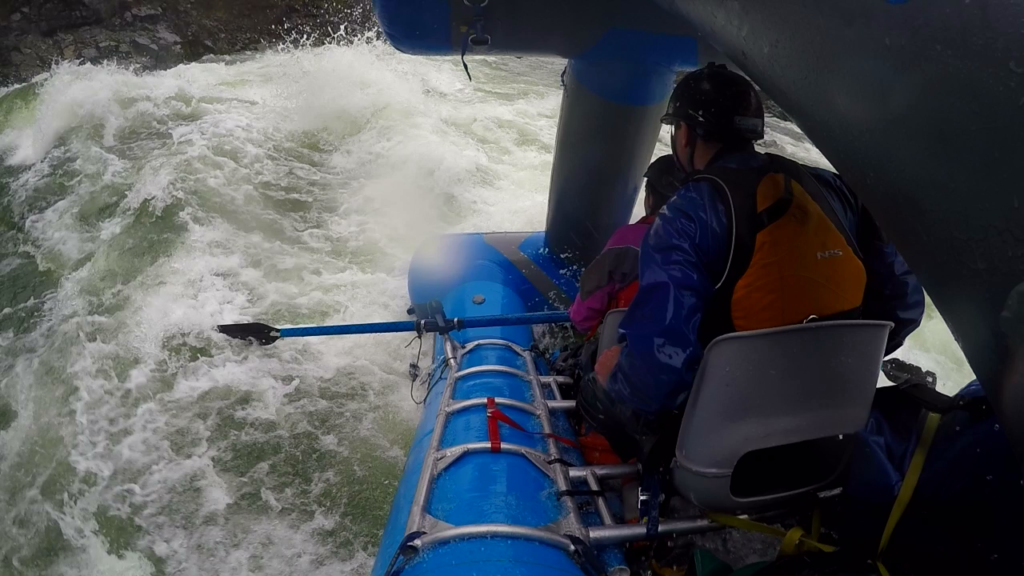
York Creek’s normal pour over holes were fairly large, especially the lower one, but easy to miss if you wanted to. We ran the left line to check out the holes, even though the right line is open. The left is a little more fun. I hit a little bit of the right side of the bottom left hole to check it out. After passing it up I though it would have been fun to drop into. Somewhat retentive, but not too mean.

At the bottom of Clear Creek there was a ledge hole that spanned nearly the entire river at the bottom. It’s formed from all the rocks that guard the left line at lower water. But again it’s easy to miss with a sneak on the right. This must be the prime flow for that hole to develop. At lower flows the rocks that form the hole emerge, and at 7000 cfs you want to drive left, and all the craziness pops up right. I eddied out below this rapid and ferried back upriver. It was amazingly easy to get below the hole, but there was too much current just below the hole to get me back in. Donny was coming down, so I pointed the line. He went right in the meat, did a quick backflip and was spit out.
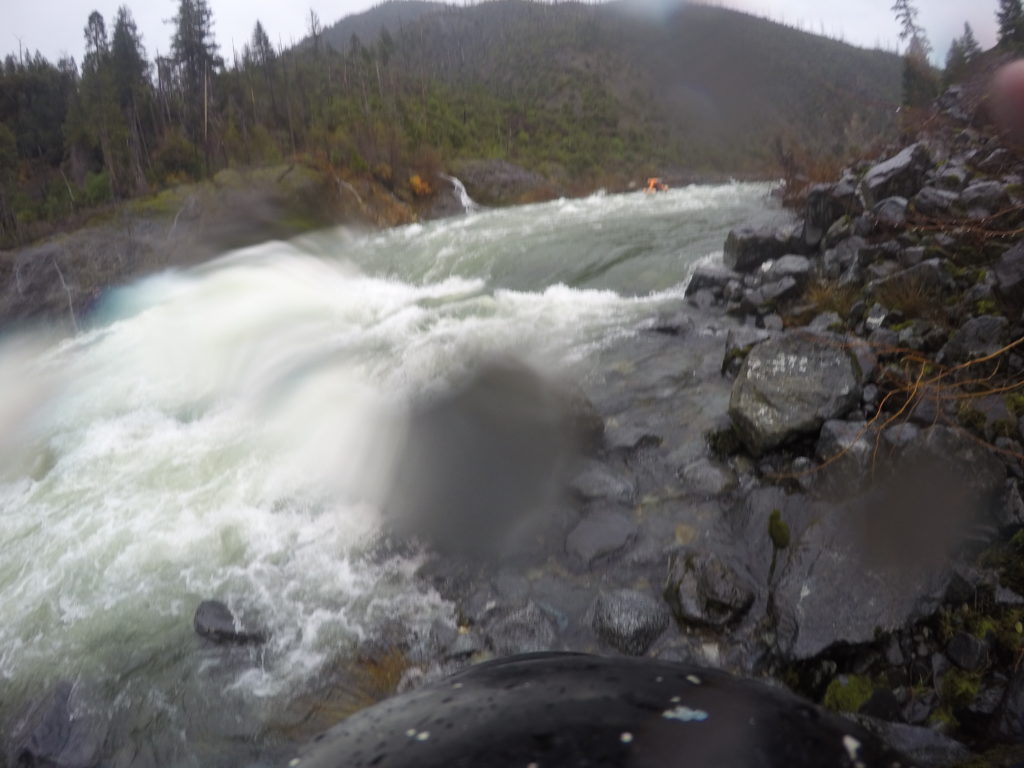
Pine Flat Rapid was fairly inconsequential, everything flushes, and there really aren’t any sticky holes. After Pine Flat the river slowed again. Dave and Marcello had to readjust there rigging and so we stopped for a quick break. Donna did some jumping around to warm up.
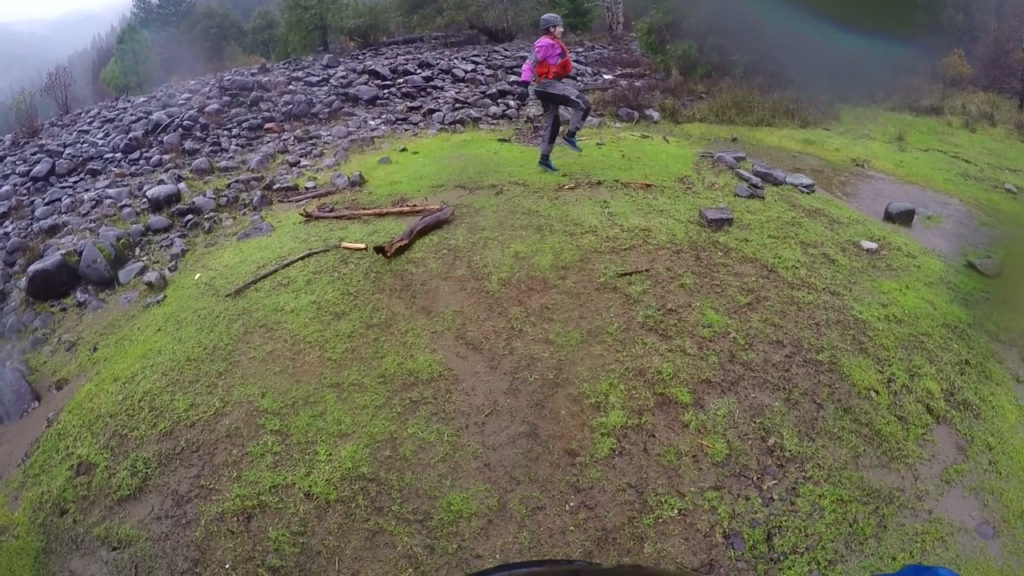
I mentioned to Donny that I didn’t think we’d make it past Green Wall before dark. He agreed. I told him we at least need to make it to Deadman’s Bar. We tried to make time. I pulled over at Klondike Creek, just in case people were interested in stopping. We kept going. A bit later we came up on Deadman’s Bar. This is a great highwater camp, but it is hard to catch, especially at high water. I let Dave know that we were coming up on Deadman’s, and we should regroup. He agreed, but not everyone caught the eddy. I wasn’t sure if it was just getting dark, or more cloudy. I was assuming a little of both. By the time we got to Red Rock, aka South Bend, it was becoming obviously dusk. I pulled over on what was left of the beach. We had about 5 to 10 feet of beach frontage, everything else was underwater. I had worried about camping here once we passed Deadman’s as it had been raining since we put on and the forecast showed rain all night. I knew there were no more decent camps until Collier at this point. Dave and Marcelo pulled over. I waved Donny over, but it was not happening. Donny kept going.
I thought to myself, this isn’t the best spot to camp anyway. The river would be rising, if not already, then soon. I didn’t want to camp on the rocks. Donny was already downstream. I was a little pissed off at the situation. I think a lot in my head, and sometimes that can become a problem with a group. I verbalize my thoughts to individuals, but since the put in I hadn’t been talking to everyone together. We were all just going along for the ride. This was my mistake, and looking back on the trip, this was the moment where a firm decision by me to stay would have been the right call.
Instead, I looked at the best case scenario and continued on our plan to reach Collier Creek. There was no room for error. I looked at Donna and said, “Well, I guess we’re going.” I felt like we had about 30 minutes before it was really dark. Which at this flow was technically enough time to get through the last 3 or 4 miles, so we jumped back in the boat. There are times when you know your decision could end badly, but most likely will be fine. So you keep going, hoping that it’s going to be that majority of time when you can push your limits.
Fawn Falls came up within a couple minutes. It was an easy pull to the right. A fairly good sized hole was starting to develop on the left. Donny was in the lead, and running the left drop he expressed his excitement. I did a little thread the needle between two holes on the right. Dave and Marcelo went left and hit a pretty good hole. Now I was in the lead. Looking back at Donny’s boat I yelled, “Alright, here we go. Green Wall.” I heard an excited yell from Donny, and assuming that meant he heard me I started rowing forward. We needed to make time.
Donna and I checked out belts. None of the scouting rocks were covered by water. I felt again a reassurance of a “raftable” flow as the river picked up speed. There was a fairly large hole about midway through prelude. I went right of it, but you could go either side.
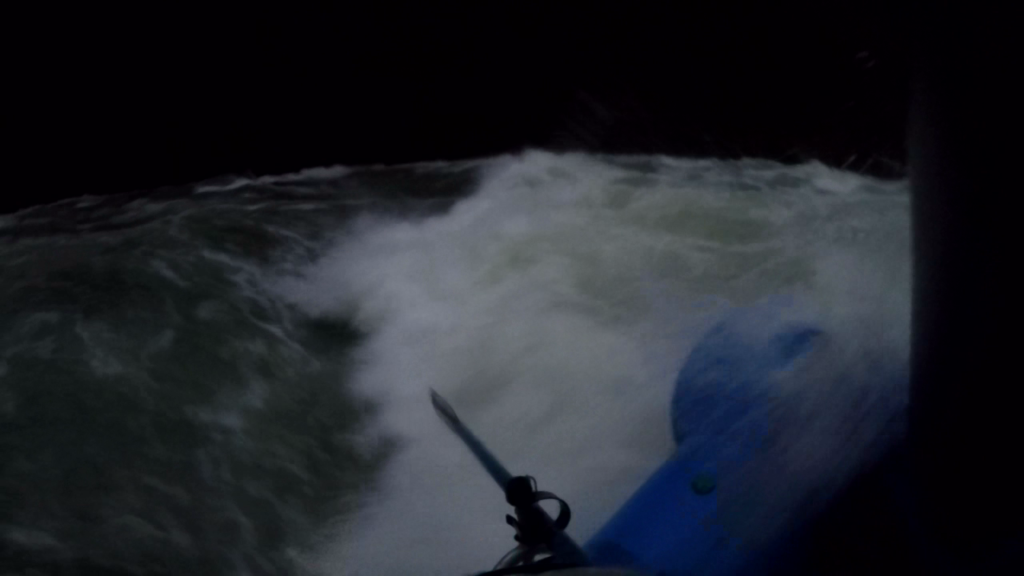
Passing the hole there are just a bunch of smaller waves, gradually growing in size. Once you reach the cliff known as the “Green Wall”, everything narrows, steepens, and you see a lot of white. There’s a very large breaking wave halfway through, probably about 10 – 12 feet high, and sometimes it would transform from a wave into a hole. You’ve got three options here. Far, left would be the raft line, taking you away from the hole, but it’s a hard pull. Second option, charge middle and square up to the hole. This almost always results in a bit of a ride. Third option, go right of this hole which looks gnarly, with a good sized lateral coming off the wall feeding into the hole. I always choose to go right at this point. It looks worse, but if you hit it correctly the front of your boat will hit the right side of the hole and stall out. You get slammed up against the lateral which tries to flip you. However, since the back end of your boat is in the faster water it grabs the low side of the back of your boat and spins you 180 degrees. You land on top of the pile. Then you’re set up to pull back and out of the hole. It seems to be the best line in my opinion at flows up to 12000. At 4000 the move worked alright, but the far right current didn’t pull me out as much as I would like and I ended up getting pulled back in towards the trough. I strained to pull back on the oars and the nose of the boat just kissed the bottom right of the trough enough to help push us out. Spinning back around we caught a couple good lateral waves coming off the right wall. This was a fun section where you felt like you were on a rollercoaster. The darkness made it seem even bigger. Then we were at the bottom. The river is still moving fast at this point but you have time a few seconds to collect your bearings and look upstream. The other boats hadn’t entered the rapid yet.
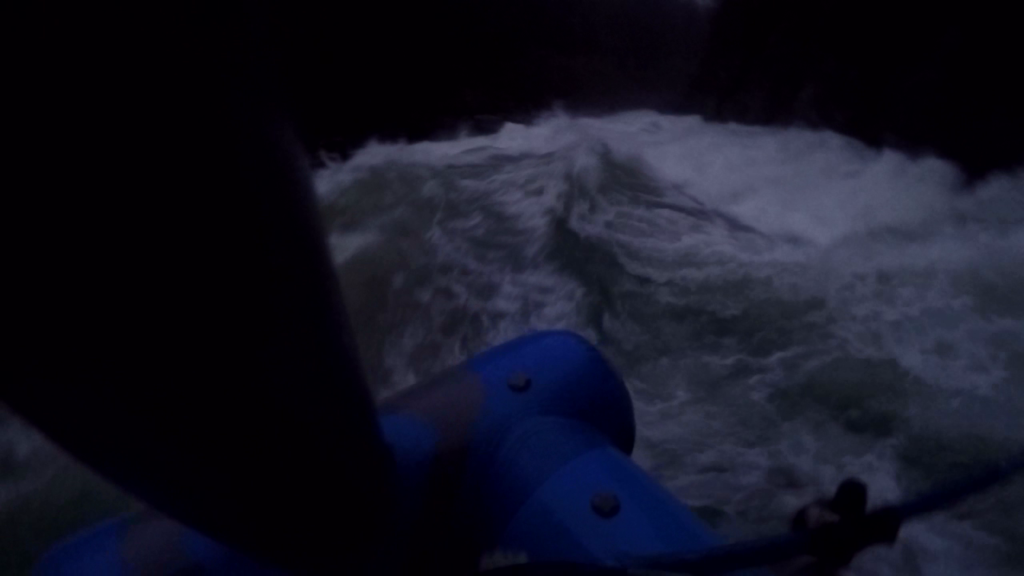
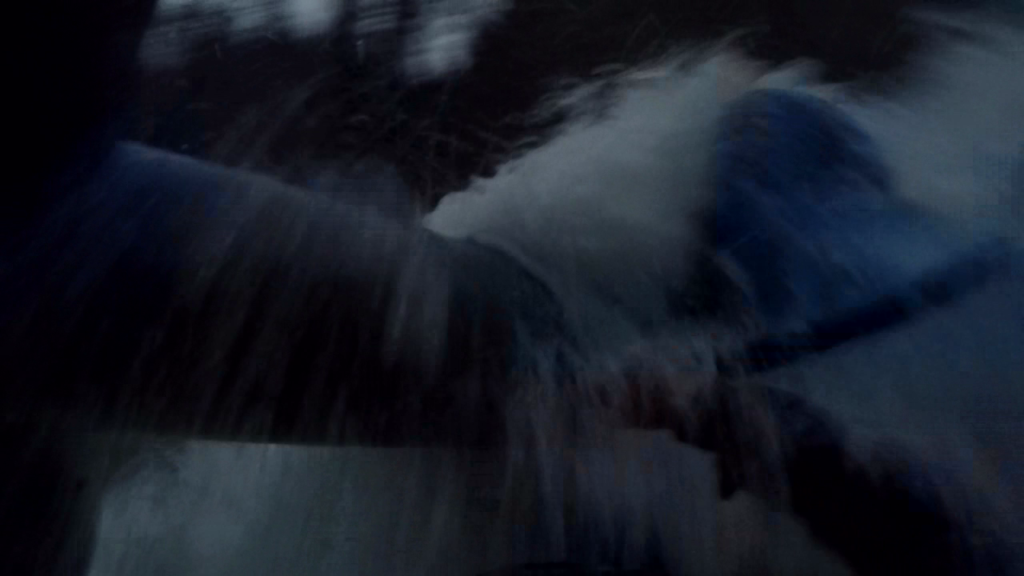
There is a large eddy on river left, and it is a real pain to get out of, especially at flows above 6k. When I got closer to the eddy on river left I could see both boats had made it through the main hole and were upright. Rather than wait in that eddy and make the hard pull, I made the pull back right, and eddied out below what I call the pinch point. The pinch point is the crux of the Green Wall at super high flows, but this evening it was just flat moving water. I noticed one of our dry bags had started to come loose. Donna adjusted our bags and watched the other boats float down.
They were all upright. We were distracted for a bit trying to tie down the loose bag. We could see Donny’s boat go right into a large hole below the Green Wall and we watched as it tumbled a bit, and then floated out upright. Dave floated by and we both communicated the normal “that was big” comments. I glanced upstream and saw Donny coming down from behind. Darkness was closing in. I felt like we had about 20 minutes of dusk left, and about 20 minutes of rowing left, so there wasn’t a whole lot of time to waste.
We approached Little Green Wall. Dave was ahead and went right into a fairly large hole in the center. His boat flipped. I manuevered around the hole and caught up to Dave who was still on his side. The temperature had been dropping and his tops were getting soft. They were both having a hard time reflipping it. I thought about throwing him a line, but we were still moving down river in some rapids and I didn’t want to get a bunch of rope dangling in the water. So we stayed close for a bit and then he drifted into an eddy I drifted down to the next one downstream. I figured he could unstrap and reflip in the eddy. Donna and I waited for a while. I felt like we really needed to get moving. I could see Donny pass Dave and then Dave flipped back over. We peeled back out and continued downstream. Again getting ahead of the group I caught an eddy behind a pour over rock.
We really needed to keep our oars in the water and make time, but I wanted to at least keep in sight of the boat behind me.
As Donny’s boat approached I heard Donna say, “Hey, where’s Donny? I don’t see him in the boat”. I looked at his boat and saw a blinking red light. Thinking it was his helmet cam I said, “No, Donny’s right there.” She said “OK”. But as the boat got closer Donna yelled again. “Aaron, Donny’s not in the boat, he’s not in the boat!”
As his boat passed I saw an empty seat and I started looking for a swimmer. We obviously hadn’t seen anyone float by while we were running the rapids, but then again we weren’t looking for anyone. After a short while more of looking around I thought to myself, maybe he helped Dave flip over and fell in. His boat got away from him and he climbed into Dave’s boat. So I told Donna we were going to go get the boat and pull it into an eddy and wait for Dave. It took us a couple minutes to catch up to the boat and ferry it to shore. There weren’t very many good eddies and I had to grab onto some branches while Donna held onto the boat. I was still holding the branches when we saw Dave approaching. He wasn’t really rowing very hard and there was a sickening feeling coming over me. “Dave”, I yelled, “where’s Donny? He’s not in his boat.”
At that moment the seriousness of our situation became apparent. We realized Donny had come out of his boat somewhere between our location and the top of the Green Wall. Whistles were blown. No sound was returned. We tied up the boats. It was getting dark dark. You could still see the white of the water, but everything else was black. I crawled into his boat and saw that his belt was completely undone. We discussed where we had last seen him, and what our options were. The last anyone could confirm seeing him was right above Green Wall, and we were at least a mile below that point. The river was high, Green Wall was huge, and again it was dark. The canyon was pretty very difficult to hike up or down in daylight, let alone in the dark. Donna started getting headlamps out of bags. I climbed up on an outcrop to see a little better. There wasn’t much to see, except that the ledge I was standing on was a lot flatter than the rockslide we were tied up to. I yelled to the group that there was a decent camp spot up here. I meant it to be relative to the riverside location. Apparently when everyone else climbed up no one else thought it was very nice. It was after all a 5′ wide shelf covered with poison oak about 20 feet above the river with another rock slide filling the shelf with medium sized pointy rocks. But it was what we had, so we made do. Donna had brought an LED lantern and she set it up on a rock as a beacon for Donny in case he was in sight. We blew more whistles and listened. Nothing. Donna and I moved rocks for our camp spot, trying to cover the poison oak, and digging into the hillside we found some dirt to try and fill in the voids in our tent spot. Dave had accidentally brought a small one person backpack tent for both himself and Marcello, so they grabbed Donny’s tent. It was huge, and took up most of the outcrop. They just set it up on top of some boulders.
Things had seriously gone wrong. We were in a bad spot. Standing in the rain, holding a piece of cold soggy chicken, I was staring out into the dark. Hoping for the sound of a whistle, and hearing only the others huddled in the tent I kept thinking about all the mistakes that had led to this moment… It was my trip, and I felt pretty bad.
Eventually I changed out of my drysuit and crawled in the big tent with everyone else. I felt a little guilty being able to crawl into a dry tent with everyone else when Donny was stuck out in the rain… or worse. Donna had a headlamp that she put on her head facing straight up so as not to blind anyone. With her hat on it made her look like a teletubby. We all got a bit of a laugh out of that one, which felt pretty good. Then we started talking about what our gameplan was going to be in the morning.
Among a few options, we eventually settled on me hiking for one hour up river as soon as it’s light to see how far I can get, and then returning. If there was no Donny we would start packing the boats and send for help. After contacting the authorities I was planning on boating back in the following day to start a search from the Green Wall down. There was this feeling of a time crunch. We all wanted to search longer, but we also felt the need to get help. Perhaps they could send a helicopter up if we made it to the authorities in time?
It was a long night. None of us slept much, and all of us heard faint yells, and/or whistles all night. None of them were real, just our hope keeping us from sleep. Eventually light came through and I started moving. I grabbed some gear and headed up river. Right away I realized this was going to be a slow process. It was super steep and unstable almost right away. I was also carrying a Bill’s Bag on my back and my river booties weren’t helping. There were many cliffed in areas where you would have to plan a route and then run across it because the slope just wouldn’t hold your weight if you stopped. I started to make some progress. Unfortunately the canyon walls got steeper and eventually I ran into a cliff that made it apparent that it would take much more than one hour to get anywhere close to the Green Wall. While searching for another route I began the hard decision of whether to leave or stay.
There wasn’t a clear cut decision. So many idea’s went through my head. Looking up at the route I knew I would need to take to get around the next cliff I knew this was a critical moment. If I went back to the rest of the group now, we could get a real rescue started, but I knew there was a good chance Donny would be staying another night in the canyon before help would arrive. If I continued hiking perhaps I could find him and if he was hypothermic or in need of help it would be critical that we find him now. If I hiked up and didn’t find him though I’d be wasting precious time. Any decision was a gamble.
I imagined a lot of scenarios, but I felt due to the ruggedness of the canyon, the immediate need of a rescue, and that we had no idea where, or what side of the river Donny ended up, I would hike back and start the rescue process.
There were at least a couple times when I turned back, thinking I can’t give up looking. I’d hike further up the hill, and then come to the realization that even if I made it around the cliff, I’d have to turn back or else the group would worry that another person was missing. I thought to myself, I’m wasting time hiking around in the woods, and we should just start the process of finding help. It was a tough decision. I didn’t want to be put in this position.
I got back to the group and let them know what I had seen and how I felt. I said I could continue hiking up canyon, but that it would take a long time and most likely I wouldn’t be able to get up to the Green Wall for a few hours one way. We don’t know what side of the river he is on, and if I can’t find him we are looking at wasting an entire day. If we leave now we can start an official rescue process and I can get back down the canyon with a boat by the following morning.
We all decided to leave a tent, sleeping bag, and some food where we were in case Donny came upon our camp after we left. We’d load the boats, leave Donny’s, and head to the takeout. From there we’d make the proper calls and then I’d head back in at first light Monday morning from Miami Bar. We knew that if a helicopter rescue was denied, that it guaranteed Donny another night in the dark before I could come back. We started packing.
I was down rigging one of the boats when I heard Dave yell. Then I heard a whistle. I hiked back up onto the outcrop and Dave said he had heard a yell. We all listened. And listened. Nothing. We all talked about all the sounds we heard last night, and decided it was another trick of the mind. Then we all heard a yell. Dave blew another whistle, and there was another yell. I have never been so happy. A huge relief surged through me. We couldn’t see him yet, but we kept blowing whistles, and a few minutes later there was Donny, a few hundred feet up on the canyon wall across from us. Not the optimal spot, but we knew he was alive. I untied one of the boats and ferried across. The river was still fast and it took me downstream a bit further than I would have liked, but he got in the boat, and we returned back to the left bank a little further downstream.
We got some hot coffee going, got him what dry clothes we had, and let him rest. Eventually we got the story.
I’m sure Donny would be able to give you a much better recollection of his ordeal, and he told a much more detailed story to us while we were sitting on the side of the river. However, this was what I remember.
He had swam from the top of Green Wall. He didn’t know at the time whether his seat belt wasn’t on, or if it just wasn’t properly attached. He fell out after going into the upper hole in Prelude. At the time he had no idea how he ended up in the water, but he couldn’t see the boat or anyone else, just big waves. He said that he kept getting recirculated in some hole for about 30 seconds, and trying not to panic, he tried to think of how he was going to get out and then he was finally flushed out. After flushing out of the hole he swam the rest of the Green Wall and somehow he had been pushed to the right bank. He pulled himself up on a rock, with his feet still in the water, he said he passed out and when he woke up it was really dark. He crawled up the steep bank and found a rock that sheltered him a little bit from the wind. He spent the night huddled next to a rock. It was a cold, rainy, dark night. Sometime during the night he fell asleep for a bit and when he woke up his helmet was gone. It was raining and he wanted to get it back to keep the rain off his head. For the life of him he couldn’t find it so he pulled his drysuit gasket over his head, ripping it, but keeping him a little warmer. I can only imagine what was going through his head all night. As soon as it was somewhat light he found his helmet about 5 feet away. He started climbing, and hiked about a mile downstream to find us.
Eventually he warmed up enough, and he said he could row his boat out. We loaded the rest of the gear on the boats and took off.
We all thought the adventure was over. I pointed out to a couple people in the group the large reversal waiting below us. “That’s the one Donny went in last time.”, I said. After yesterday, with Donny losing the boat, we had exhausted all our spare oar blades. We couldn’t afford to break another one. Everyone agreed to stay out of big holes.
Rapid #103 in Quinn’s book is normally a class 3+ rapid with some boulder maneuvering, but the river takes you where you need to go at lower levels, so it’s usually a pretty easy one. Today it was a little different, and as luck would have it I ended up exactly where I told everyone else not to go. And I was the last boat. Even after watching the video I feel like I was set up perfectly, but avoiding the medium size hole that was somewhat blocking the right sneak I ended up riding right on top of the frothy water created behind the ledge hole I was trying to avoid. Staring back down into the hole I tried to pull away, but feeling the boat tilting into the hole I could tell it wasn’t going to let us go. It was a lot like a lowhead dam, and there was a large amount of water pushing me back into the center, which was keeping me from escaping on either side.

Three minutes and twenty seconds later we got out, with one blade completely sheared off, and another bent about 25 degrees, I was able to eddy out and assess the situation. We were fine physically, the surf wasn’t that bad for us, but we didn’t have anymore blades. I conversed with Donna a bit, and we pulled back out into the water with one oar. I felt there wasn’t really much danger of wrapping, as the river was high enough to cover most rocks. Although I couldn’t be sure of every rock, and I knew we would have pretty poor handling. The other choice for us would be to stay there and wait. Maybe make a blade out of a piece of wood? I thought we’d just start moving downstream. I kept an eye open for any flat pieces of wood though.
The rest of the group had been waiting for me around the corner and Marcelo was walking up with a throw bag. I made sure they saw I had one oar. We kept going. Below us was another class 4 rapid, but I knew at this level any of the rocks would be well covered, and until Sub Hole I wasn’t expecting any large holes.
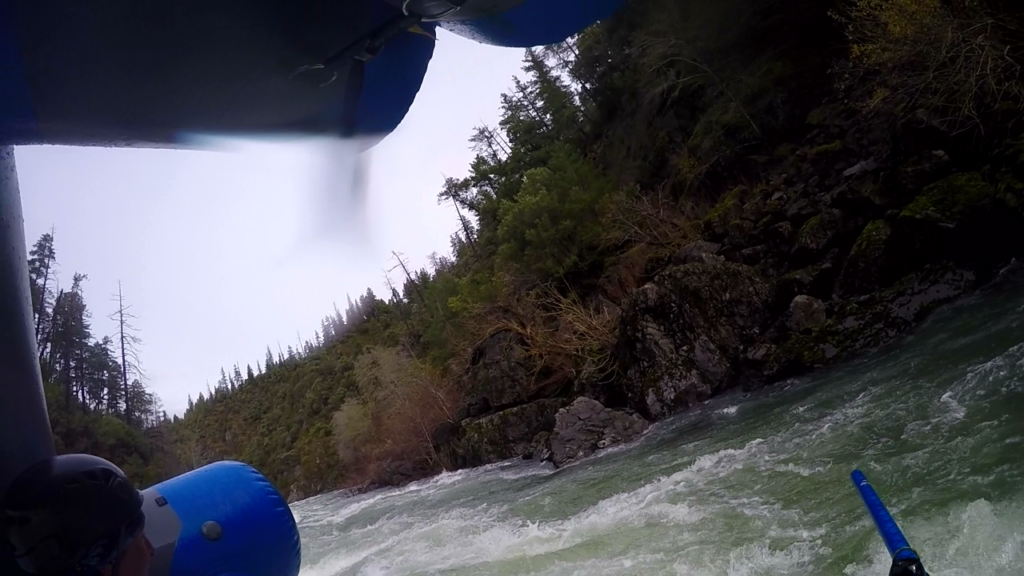
This turned out to be the case. I was worried about Sub Hole as I was imagining a mean hole in the bottom center, and was worried we wouldn’t be able to avoid it. However, it ended up not amounting to anything and we made it through the bigger rapids without consequence. I was able to use the shaft of the oar to grab a little water, and I used the waves and current to push me where I wanted to go. Donna cracked up quite a few times watching me stroke the left oar about a hundred times only to just barely touch the water with the right. I thought again about trying to use a piece of wood to tie onto the oar shaft for a temporary blade. If I thought we were going to run into problems I would have pulled over and done this. But that would have taken some time. At this point, Donny was getting cold, and he wasn’t able to warm up by rowing. We needed to get out, so we kept pushing.
All of us limped out of the canyon. Some cold, some tired, but all of us were humbled.
We made it out just after 12 PM. Bearfoot Brad was waiting for us. We put Donny in the truck with the heaters on. The rest of us rolled the boats, loaded gear, climbed in the truck, and headed home.
Lots of lessons were learned on this trip. I still question my decision to leave when I was hiking in the morning. Perhaps I should have stayed longer to look. However, I realize no matter what decision I made at that moment no one could predict the outcome. It was a gamble either way. The only thing that I knew for sure was that a decision needed to be made.
Fortunately for everyone this trip ended well. Everyone made mistakes, and I believe everyone acknowledges those mistakes and has learned from them.
Everything seems so obvious in hindsight, and I think most important lesson we learned from this trip is to just stop and take a moment. At any point during this trip if we all just stopped and talked a bit, I’m sure you wouldn’t be reading this story today.

